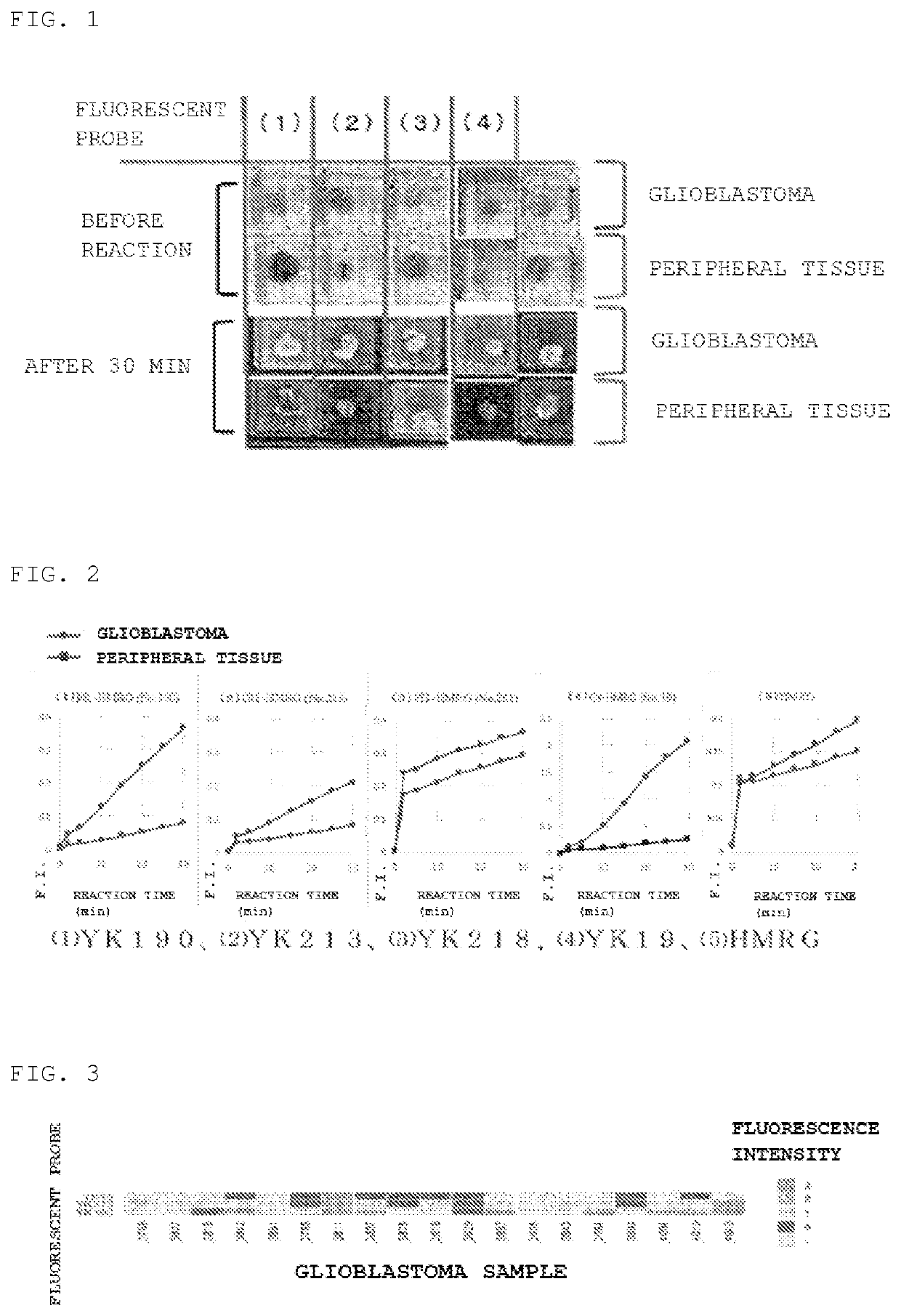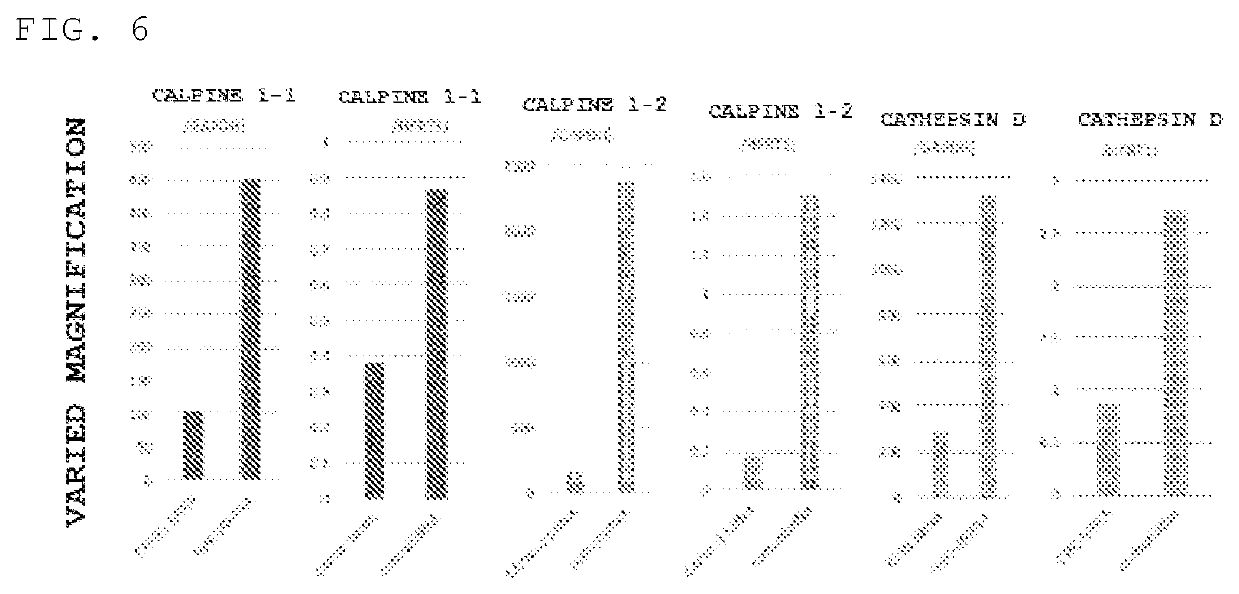Fluorescent probe for use in detection of brain tumor
a fluorescent probe and brain tumor technology, applied in the field of brain tumor fluorescence probes, can solve the problems of inability to extend the excision to the surrounding brain, glioma often becomes more malignant, and rarely achieve complete cure, etc., to achieve the effect of improving the removal ratio, high sensitivity, and increasing the possibility
- Summary
- Abstract
- Description
- Claims
- Application Information
AI Technical Summary
Benefits of technology
Problems solved by technology
Method used
Image
Examples
example 1
[0077]1. Synthesis of Fluorescent Probe
[0078]Hydroxymethyl rhodamine green (HRMG) having various dipeptide sites was synthesized in accordance with the reaction scheme described in Example 1 of WO 2016 / 006678. Compounds having different dipeptide sites were obtained by variously changing the Fmoc-amino acid used in the synthesis of compound A7 in Example 1.
[0079]The synthesized compound is one in which in the aforementioned formula (I), all of R1, R2, R3, R4, R5, R6, R7, R8 and R9 are hydrogen atoms, X is O, Y is a methylene group, and a combination of P1 and P2 is as follows.
TABLE 1CompoundP1P2YK190ArginineProlineYK213HistidineGlycineYK19TyrosineGlycineYK281Methionine sulfoxideAcetylleucine
example 2
[0080]2. Screening by Fluorescent Probe
[0081]The fluorescent intensity of fresh glioblastoma and peritumoral tissue were compared using the fluorescent probes YK190, YK213, YK19, and YK281 synthesized in Example 1. As a comparative example, hydroxymethyl rhodamine green (HRMG) having no dipeptide site was used.
[0082]50 μM probe solutions (200 μL) in PBS, containing 0.5% v / v DMSO as a co-solvent was added dropwise to each specimen, and the fluorescence intensity was measured over time using Maestro In Vivo Imaging System Ex.[0083]Excitation wavelength: 465 nm[0084]Emission wavelength: 515 nm
[0085]As a result, as shown in FIGS. 1 and 2, fluorescent labeling was performed in a tumor-specific manner as compared with the surrounding tissue for (1) YK190 and (2) YK213, whereas there was no significant difference as compared with the surrounding tissue for (3) YK218. (5) HRMG is a comparative example having no dipeptide site on the side chain. As shown in FIG. 2, both YK190 and YK213 exhib...
example 3
[0087]3. Identification of Protease
[0088]Next, the protease involved in the fluorescent response obtained in Example 2 was identified.
[0089]Protease analysis was performed by a DEG (diced electrophoresis gel) assay and peptide mass fingerprinting using LC MS / MS (liquid chromatograph-mass spectrometry) and as candidate enzymes, cathepsin D, cytosolic nonspecific dipeptidase, calpain 1 and cytosolic aminopeptidase were identified.
[0090]For these candidate enzymes, a change in fluorescence intensity was detected using inhibitors (SNJ-1945 and Amastatin), and the results showed that fluorescence suppression by SNJ-1945 occurred for calpain 1 and cathepsin D.
[0091]For calpain 1 and cathepsin D purified enzymes, a change in fluorescence intensity by the reaction with the fluorescent probe YK190 was measured, and the results showed that, as shown in FIG. 4, a significant increase in fluorescence intensity was observed. Therefore, it was suggested that the fluorescent response to glioblasto...
PUM
| Property | Measurement | Unit |
|---|---|---|
| wavelength | aaaaa | aaaaa |
| fluorescence wavelength | aaaaa | aaaaa |
| fluorescence wavelength | aaaaa | aaaaa |
Abstract
Description
Claims
Application Information
 Login to View More
Login to View More - R&D
- Intellectual Property
- Life Sciences
- Materials
- Tech Scout
- Unparalleled Data Quality
- Higher Quality Content
- 60% Fewer Hallucinations
Browse by: Latest US Patents, China's latest patents, Technical Efficacy Thesaurus, Application Domain, Technology Topic, Popular Technical Reports.
© 2025 PatSnap. All rights reserved.Legal|Privacy policy|Modern Slavery Act Transparency Statement|Sitemap|About US| Contact US: help@patsnap.com



